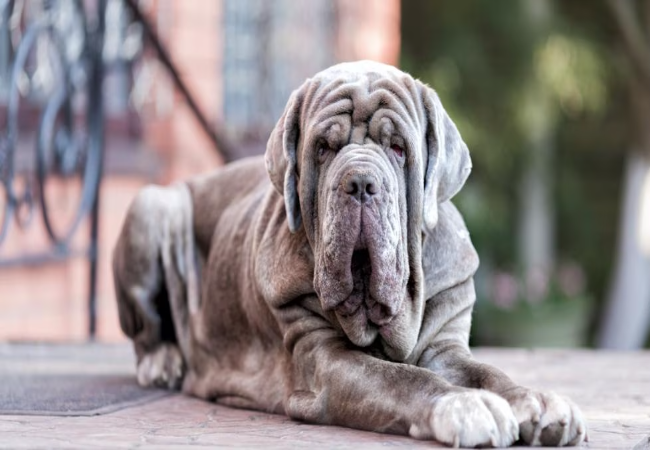Neapolitan Mastiff 2025: Gentle Ancient Guardian Health & Care🐶

In this article
Neapolitan Mastiff 2025: Gentle Ancient Guardian Health & Care🐶
By Dr. Duncan Houston BVSc
Introduction 🌟
The Neapolitan Mastiff—also known as “Mastino Napoletano”—is an imposing yet affectionate Italian guardian breed with roots tracing to Roman war dogs. Celebrated for its loose, wrinkled skin and calm presence, this gentle giant blends protective instincts with a deeply loyal nature.
1. Origins & History 📜
- Descends from ancient Molossian dogs and was used in combat and estate guarding since Roman times.
- The modern standard emerged post-WWII through breeders like Piero Scanziani and Mario Querci, emphasizing loose skin and powerful structure.
- Officially recognized in Italy (1949), FCI (1956), and AKC Foundation Stock Service (2004).
2. Size & Appearance 🧩
- Height: 24–31 in; Weight: 110–150 lb.
- Huge, muscular structure with heavy bone, loose skin, and deep wrinkles, especially on the head.
- Coat: short and smooth in colors like black, grey, fawn, mahogany, often with a dark mask.
3. Temperament & Personality ❤️
- Laid-back indoors, but highly protective—bonded deeply to family with a reserved stance toward strangers.
- Not prone to aggression without cause; likes to be near loved ones while quietly vigilant.
- Generally tolerant of children; caution advised due to its massive size.
4. Exercise & Lifestyle 🏡
- Low-to-moderate energy—20 min twice daily for adults to support joint health and weight management.
- Puppies should avoid high-impact activity to protect growing joints.
- Best suited to homes with yards and calm routines; apartment living is possible with structured outings.
5. Grooming & Skin Care ✂️
- Brush weekly to control light shedding; bathe as needed.
- Daily cleaning and drying of wrinkles is critical to prevent infections and dermatitis.
- Routine nail trims, ear checks, and daily mouth-wrinkle cleaning due to drooling.
6. Health & Lifespan 🩺
Life expectancy: 7–9 years; median lifespan ~9.3 years.
- Hip/elbow dysplasia: Common; OFA/PennHIP screening recommended.
- Cardiac issues: Dilated cardiomyopathy and murmurs warrant echocardiograms.
- Bloat (GDV): High risk in deep-chested breeds; consider gastropexy.
- Skin fold problems: Dermatitis, pyoderma in wrinkles; cherry eye, entropion, ectropion.
- Others: Demodectic mange, dental disease, obesity, hypothyroidism, and cruciate injuries.
7. Nutrition & Feeding 🍽️
- Feed high‑quality large‑breed puppy food while growing, then adult large‑/giant‑breed formulas.
- Adults require two meals daily; use slow feeders and ground-level bowls to reduce bloat risk.
- Supplements: omega‑3s for skin, joint support; vet‑recommended as needed.
8. Training & Socialization 🎓
- Early, consistent socialization is critical—focus on guests, dogs, and environments from puppyhood.
- Responds best to positive reinforcement—avoid punishment.
- Gentle but firm leadership helps manage stubborn traits; training should begin by 8 weeks.
9. Family Fit & Environment 🏡
- Ideal for experienced owners who appreciate slow-moving, loyal companions.
- Great bonds with children and family—but supervision is key due to size.
- Not suitable for small-pet households unless those animals are raised with the dog.
10. Pros & Cons ⚖️
- Pros: Deeply loyal, protective, low-energy, minimal grooming
- Cons: Health risks, drooling, training needs, short lifespan, size constraints
11. Adoption & Breeder Tips 🌟
- Rescue groups and breed-specific rescues exist, though rare due to pricing.
- Choose breeders performing OFA/PennHIP (hips/elbows), cardiac, and ocular clearances.
- Price range: $3,500–5,000+; adult adoptions often lower.
12. FAQs ❓
- Do they drool? Yes—drool a lot; use mats and clean folds daily.
- Are Neos aggressive? No—gentle unless threatened; proper training prevents issues.
- How much exercise? Low–moderate; a couple of short walks daily.
- Apartment‑friendly? Possible with regular outings and space but better in homes.
- How long do they live? 7–9 years on average.
13. Ask A Vet, 🐶
- Ask A Vet: Expert advice on bloat prevention, skin-fold hygiene, joint care, heart checks, and drool management.
14. Final Thoughts ✅
The Neapolitan Mastiff is a breathtaking blend of ancient guardian strength and tender devotion. Ideal for focused owners who can meet its physical, emotional, and financial needs, this gentle giant shines with proper care, training, and love. To support your Neo’s wellbeing, visit AskAVet.com and download the Ask A Vet app for tailored guidance and lifelong support.






